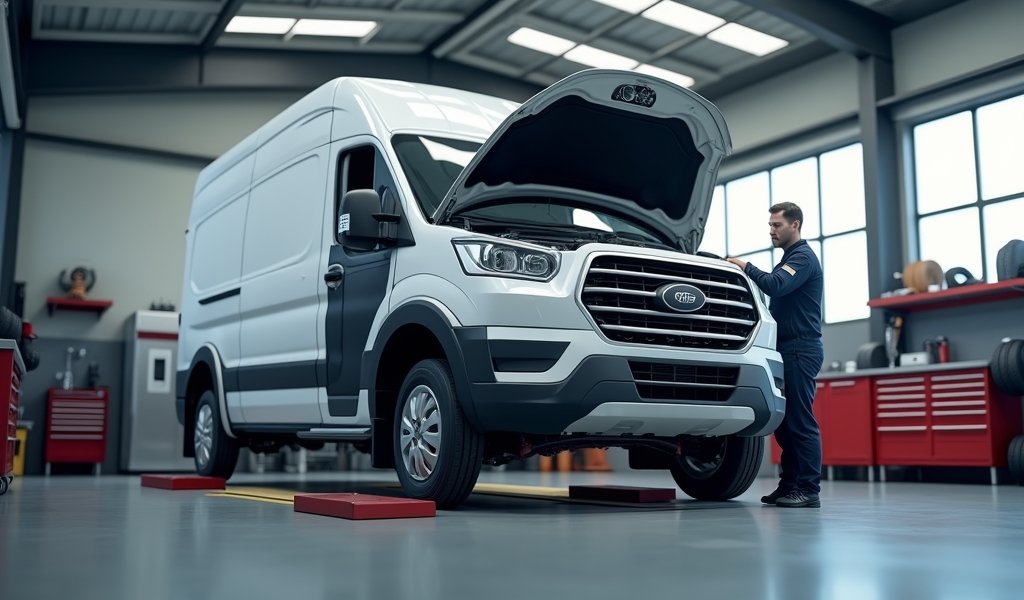Overview
This article provides ten expert strategies for effective fleet vehicle maintenance, including implementing preventative maintenance schedules, driver inspection protocols, data tracking, proper fluid management, and leveraging telematics for predictive maintenance. Written by a master fleet mechanic with over 20 years of experience, it emphasizes that proper fleet maintenance is an investment that pays dividends through improved reliability, enhanced fuel economy, and reduced total ownership costs.
Table of Contents
- Introduction
- Establish a Preventative Maintenance Schedule
- Implement Driver Vehicle Inspection Reports (DVIRs)
- Track and Analyze Maintenance Data
- Train Drivers on Basic Maintenance
- Choose the Right Service Providers
- Optimize Fluid Management
- Focus on Tire Maintenance
- Implement a Parts Inventory System
- Leverage Telematics for Predictive Maintenance
- Develop Vehicle Replacement Strategies
- Conclusion
- Frequently Asked Questions
Introduction
In my 20+ years as a master fleet mechanic, I’ve seen firsthand how proper fleet vehicle maintenance transforms business operations. It’s not just about keeping wheels turning—it’s about protecting your investment and boosting your bottom line.
Fleet vehicles endure more stress than personal vehicles, covering greater distances under tougher conditions. When these workhorses break down unexpectedly, it doesn’t just mean repair costs—it means missed deliveries, unhappy customers, and lost revenue.
The good news? A strategic approach to fleet vehicle maintenance can dramatically reduce these headaches while extending vehicle lifespans and improving safety. A well-maintained fleet isn’t a cost center—it’s a competitive advantage that pays dividends through improved reliability, enhanced fuel economy, and reduced total ownership costs.
Let’s dive into my ten field-tested tips for keeping your fleet running at peak performance without breaking the bank. These strategies work whether you’re managing three vehicles or three hundred.
Establish a Preventative Maintenance Schedule
The cornerstone of effective fleet management is a rock-solid preventative maintenance schedule. I can’t count how many catastrophic failures I’ve seen that could have been prevented with regular, scheduled maintenance. The old saying rings true: an ounce of prevention really is worth a pound of cure.
Start by gathering manufacturer recommendations for each vehicle type in your fleet. These specifications provide your baseline, but remember—they’re designed for average use. Your real-world conditions might demand adjustments.
A comprehensive maintenance schedule by mileage should include:
- Oil changes (typically every 5,000-7,500 miles for conventional oil)
- Transmission fluid service (usually every 30,000-60,000 miles)
- Brake inspections (at least twice yearly)
- Air filter replacement (every 15,000-30,000 miles)
- Cooling system service (typically every 30,000 miles)
- Timing belt replacement (usually 60,000-100,000 miles)
- Battery testing (every 6 months)
The key is consistency. Create a system that flags upcoming maintenance needs and tracks completion. Many fleet managers I work with use software that automatically generates work orders based on mileage readings or calendar dates.
For larger fleets, consider staggering maintenance schedules to maintain operational capacity. This approach prevents multiple vehicles from being out of service simultaneously.

Implement Driver Vehicle Inspection Reports (DVIRs)
Your drivers are your first line of defense against developing mechanical issues. They feel the subtle vibrations, hear the emerging squeaks, and notice handling changes before anyone else. Implementing a thorough Driver Vehicle Inspection Report (DVIR) system harnesses this valuable intelligence.
For commercial vehicles, pre-trip and post-trip inspections aren’t just smart practice—they’re required by federal regulations. But even for light-duty fleets not subject to these rules, daily inspections catch problems before they become roadside emergencies.
Effective DVIRs should include quick checks of:
- Tire condition and pressure
- All lighting systems
- Fluid levels and evidence of leaks
- Windshield and wiper condition
- Braking performance
- Warning lights and gauges
- Unusual noises or handling characteristics
Modern digital DVIR apps streamline this process, replacing cumbersome paperwork with simple mobile forms. These tools allow drivers to quickly submit reports with photos of concerning issues, automatically notifying fleet managers when immediate attention is needed.
Make sure your drivers understand that reporting issues isn’t “getting the vehicle in trouble”—it’s preventing downtime. Create a culture where early problem reporting is rewarded rather than punished.
Track and Analyze Maintenance Data
In my shop, we live by the mantra: “If you can’t measure it, you can’t improve it.” Thorough maintenance tracking transforms gut feelings into actionable insights. The fleets that consistently outperform their peers are those making decisions based on comprehensive data rather than hunches.
Modern fleet management systems make data collection easier than ever. These platforms track everything from routine service to major repairs, creating a complete maintenance history for each vehicle.
Focus on tracking these key metrics:
- Cost per mile for maintenance and repairs
- Downtime frequency and duration
- Mean time between failures
- Parts replacement frequency
- Labor hours by service type
- Fuel efficiency trends
- Warranty recovery opportunities
This data reveals patterns invisible to the naked eye. You might discover that vehicles operating in specific regions experience more suspension issues, or that certain model years consistently develop electrical problems after hitting 75,000 miles.
Regular analysis helps identify problematic vehicles, recurring issues, and maintenance trends. I recommend quarterly reviews of maintenance data to spot emerging patterns. This practice allows you to adjust maintenance intervals, identify training opportunities, and make informed decisions about future vehicle purchases.
Train Drivers on Basic Maintenance
Your drivers don’t need to become master technicians, but some basic maintenance knowledge goes a long way. I’ve seen countless major breakdowns that began as minor issues drivers either didn’t recognize or didn’t report.
A few hours of training can save thousands in repairs and downtime. Focus on teaching practical skills like:
- Proper vehicle inspection techniques
- Checking and topping off fluids
- Measuring tire pressure accurately
- Identifying common warning signs (unusual sounds, smells, or handling)
- Jump-starting procedures
- Emergency roadside protocols
Beyond technical skills, help drivers understand how their driving habits affect vehicle longevity. Heavy acceleration, aggressive braking, and excessive idling dramatically increase maintenance requirements. When drivers connect these behaviors to vehicle health, they naturally adjust their habits.
Create easy reference materials drivers can keep in their vehicles. Quick-reference guides for fluid specifications, tire pressures, and warning light meanings prove invaluable during roadside situations.
Consider implementing a vehicle service checklist for drivers to follow during their routine inspections. This standardizes the process and ensures nothing gets overlooked.

Choose the Right Service Providers
Selecting maintenance partners is a critical decision that impacts reliability, downtime, and costs. I’ve seen the full spectrum—from in-house maintenance operations to national service contracts to local independent shops. Each approach has merits depending on your fleet size, geographic spread, and operational requirements.
For smaller, localized fleets, building relationships with trusted independent shops often delivers the best value. These providers typically offer more personalized service and flexibility than dealerships or national chains.
Larger fleets might benefit from national service agreements that provide consistent pricing and procedures across regions. Many of these providers offer mobile maintenance that services vehicles at your location, minimizing downtime.
When evaluating service providers, look beyond hourly rates to assess total value:
- Technician certifications and specializations
- Parts quality and warranty policies
- Diagnostic capabilities for your specific vehicles
- Typical turnaround times
- After-hours availability
- Communication practices
- Preventative maintenance capabilities
Consider testing potential providers with small jobs before committing your entire fleet. This approach reveals their actual practices rather than just their sales promises.
Regardless of your service provider arrangement, maintain detailed records of all work performed. These records ensure consistent service approaches across providers and facilitate warranty claims when necessary.
Optimize Fluid Management
If vehicles were human, fluids would be their lifeblood. In my decades turning wrenches, I’ve seen countless catastrophic failures that began with neglected fluid maintenance. A strategic approach to fluid management delivers some of your best returns on maintenance investment.
Engine oil deserves special attention. Today’s engines run hotter and under tighter tolerances than ever before, making oil quality and change intervals critical. For severe service fleets—those with heavy loads, frequent stops, or dusty conditions—standard intervals often prove insufficient.
Consider implementing oil analysis programs that examine samples for contaminants and breakdown. This approach allows extending intervals when conditions permit while providing early warning of developing engine issues.
Don’t overlook these other vital fluids:
- Transmission fluid (deteriorates over time even without visible contamination)
- Brake fluid (absorbs moisture, compromising safety)
- Power steering fluid (often ignored until systems fail)
- Coolant (critical for preventing corrosion and overheating)
For coolant specifically, regular testing goes beyond just checking the freeze point. Modern coolants contain additives that prevent corrosion within the cooling system. These additives deplete over time, even when the coolant looks perfectly clean. EPA guidelines suggest that proper fluid maintenance can improve fuel efficiency by up to 2%.
Establish clear specifications for all fluids used in your fleet. The modest cost difference between basic and premium fluids often pays dividends through extended component life.
Focus on Tire Maintenance
Tires represent your single most important safety system and a significant ongoing expense. Throughout my career, I’ve seen countless examples where simple tire maintenance practices dramatically extended tire life while improving safety and fuel economy.
Inflation pressure stands as the most critical tire maintenance factor. Even small deviations from recommended pressures accelerate wear patterns and reduce fuel efficiency. Routine vehicle maintenance should always include pressure checks.
Establish these tire maintenance protocols:
- Weekly pressure checks (adjusted for ambient temperature)
- Regular rotation every 5,000-7,000 miles
- Alignment checks after hitting potholes or curbs
- Tread depth monitoring (replace at 4/32″ for safety)
- Visual inspections for damage or irregular wear
- Valve stem replacement with each new tire
For larger commercial fleets, retreading offers significant cost savings without compromising safety when properly managed. Develop clear guidelines for which positions can use retreads and establish quality standards for your retreading vendor.
Consider using tire pressure monitoring systems (TPMS) across your fleet. Modern TPMS solutions integrate with telematics platforms to provide real-time alerts for underinflation, allowing immediate intervention before damage occurs.
Train drivers to recognize irregular tire wear patterns, as these often indicate alignment issues that, when addressed promptly, extend tire life substantially.
Implement a Parts Inventory System
Finding the sweet spot in parts management balances downtime risk against carrying costs. I’ve seen operations crippled by parts shortages and others wastefully overstocked. The optimal approach varies by fleet size, vehicle types, and operational requirements.
Start by analyzing your maintenance history to identify commonly replaced parts. Focus your inventory on components that:
- Fail frequently based on historical data
- Cause significant downtime when unavailable
- Have long procurement lead times
- Can be economically purchased in bulk
For geographically dispersed fleets, consider regional parts caches that service multiple locations. This approach improves parts availability without duplicating inventory across all facilities.
Implement inventory tracking systems that maintain minimum quantities and automatically generate purchase orders when stock reaches reorder points. These systems also track parts consumption patterns, helping optimize inventory levels over time.
Develop relationships with parts suppliers that offer same-day or next-day delivery for non-stocked items. Many suppliers provide vendor-managed inventory programs where they maintain stock levels based on your usage patterns.
For specialized equipment or older vehicles, identify alternative sources for critical components before emergencies occur. This preparation prevents extended downtime while searching for hard-to-find parts.
Quality matters tremendously with replacement parts. The National Highway Traffic Safety Administration notes that substandard replacement parts can compromise vehicle safety systems and lead to premature failures.
Leverage Telematics for Predictive Maintenance
The maintenance game changes completely with modern telematics systems. What was once reactive guesswork becomes proactive precision. I’ve watched telematics transform fleet operations by catching problems before they cause roadside failures.
These systems connect directly to the vehicle’s diagnostic systems, providing real-time data on engine performance, fault codes, and operating conditions. This wealth of information enables truly predictive maintenance based on actual vehicle condition rather than just mileage intervals.
Advanced telematics systems can detect subtle performance changes that indicate developing issues. For example:
- Gradual increases in engine temperature suggesting cooling system problems
- Battery voltage fluctuations indicating charging system deterioration
- Transmission shift pattern changes preceding major failures
- Fuel system pressure variations that predict pump failures
- Brake application force changes suggesting hydraulic system issues
This intelligence allows you to schedule maintenance exactly when needed—not too early (wasting resources) and not too late (risking failures). The most sophisticated systems even integrate with maintenance management platforms to automatically generate work orders when specific conditions occur.
Beyond vehicle health monitoring, telematics provide valuable context by correlating maintenance needs with operational factors. You might discover that vehicles on certain routes experience accelerated wear patterns, or that specific drivers consistently generate more maintenance requirements.
For fleets looking to maximize uptime while optimizing maintenance spending, telematics represents the single most powerful tool available today.
Develop Vehicle Replacement Strategies
Every vehicle eventually reaches the point where replacement makes more financial sense than continued maintenance. Developing a strategic approach to vehicle replacement prevents throwing good money after bad while optimizing capital expenditures.
The classic approach relies on establishing replacement triggers based on some combination of age, mileage, and condition. While useful as a starting point, sophisticated fleet operators now incorporate total cost of ownership analysis that considers:
- Acquisition costs (purchase price or lease payments)
- Maintenance expense trends (are costs increasing rapidly?)
- Reliability data (frequency and severity of breakdowns)
- Downtime impacts on operations
- Fuel efficiency compared to newer models
- Resale or residual value projections
- Technological advancements in newer models
- Safety feature improvements
Most fleets experience a “sweet spot” where total ownership costs reach their minimum—typically just before major components like transmissions and engines begin failing. Data analysis helps identify this optimal replacement point for each vehicle type in your operation.
Create a phased replacement schedule that distributes capital expenditures evenly across budget years. This approach prevents the financial strain of replacing multiple vehicles simultaneously while continuously modernizing your fleet.
When replacing vehicles, standardize specifications where operationally feasible. Standardization reduces parts inventory requirements, simplifies maintenance procedures, and often enables bulk purchasing discounts.
Conclusion
Fleet vehicle maintenance isn’t just about fixing what breaks—it’s about creating systems that prevent failures, optimize performance, and maximize return on your vehicle investments. The ten strategies we’ve explored form a comprehensive approach that will transform how your fleet operates.
Start by assessing your current maintenance practices against these best practices. Identify gaps and opportunities for improvement, then implement changes systematically rather than trying to overhaul everything at once.
Remember that successful fleet maintenance is ultimately about people as much as vehicles. Foster a culture where drivers and technicians take ownership of vehicle condition, where data drives decisions, and where maintenance is viewed as an investment rather than an expense.
The results will speak for themselves: extended vehicle lifespans, reduced downtime, improved safety, and significant cost savings. Most importantly, you’ll gain the operational reliability that keeps your business moving forward without interruption.
Your fleet vehicles are the workhorses that power your business. Treat them right, and they’ll deliver the performance and longevity your operation depends on.
Frequently Asked Questions
How often should fleet vehicles have routine maintenance?
Most fleet vehicles should follow manufacturer-recommended intervals, typically every 5,000-7,500 miles for basic service. Adjust these intervals based on operational conditions, with more frequent service for severe duty applications.
What’s the most cost-effective way to maintain a small fleet?
For small fleets, build relationships with reliable independent service providers and implement rigorous preventative maintenance schedules. Track all maintenance data meticulously to identify cost-saving opportunities and potential problem vehicles.
How can I reduce fleet fuel costs?
Regular maintenance significantly impacts fuel economy, particularly air filter replacement, tire pressure maintenance, and fuel system cleaning. Combine this with driver training on efficient driving techniques and route optimization for maximum savings.
Should I invest in an in-house maintenance facility?
In-house maintenance facilities typically become cost-effective for fleets with 25+ vehicles. Analyze your current maintenance spending, downtime costs, and operational requirements before making this substantial investment.
How do I know when to replace fleet vehicles?
Replace vehicles when maintenance costs consistently increase and reliability decreases. Most fleets find their optimal replacement point between 100,000-150,000 miles, though this varies by vehicle type and application.

